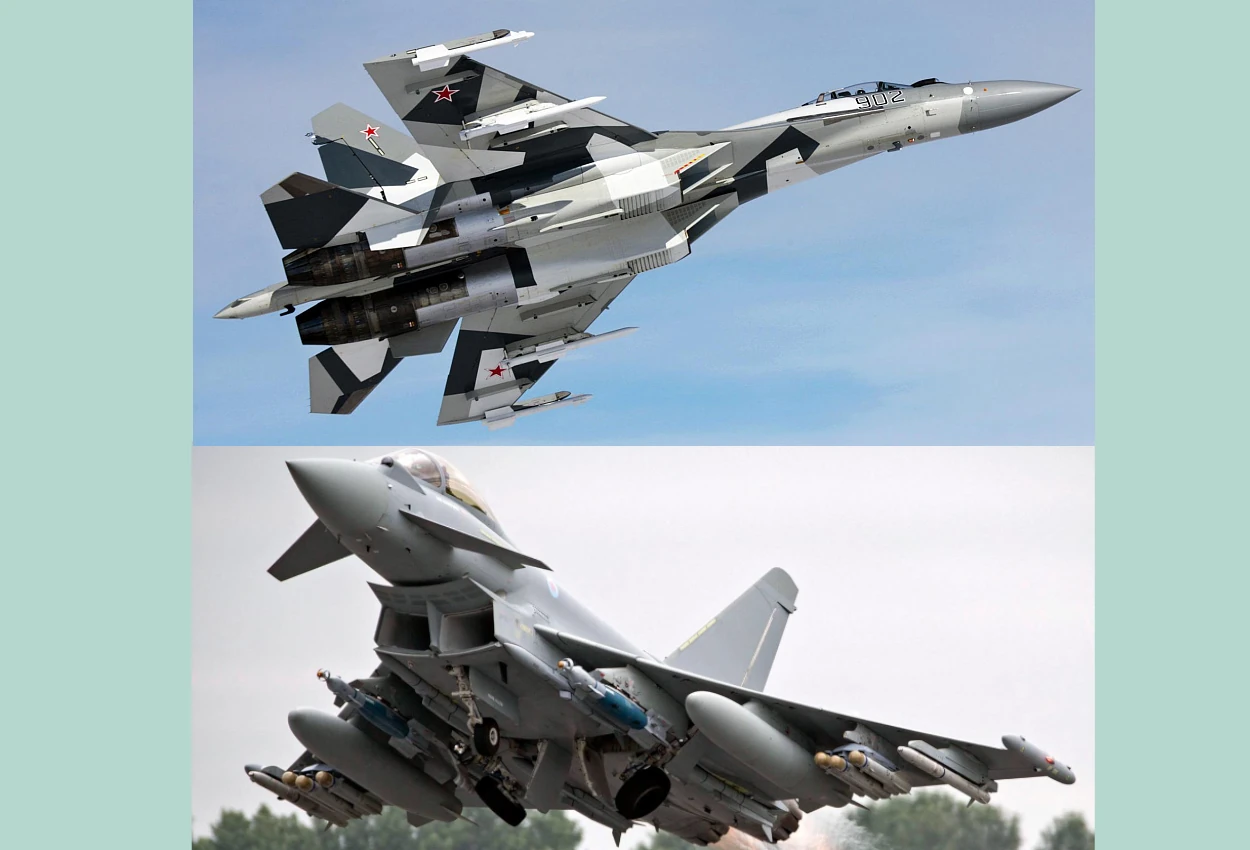
American analyst Dave Majumdar presented a possible collision in the sky of these military vehicles. Although the probability of such a situation, Dave considers it unlikely.
The expert, recalling the exercises of the Su-35 and the British Eurofighter Typhoon, noted that the Russian aircraft made a positive impression on the English pilots. In particular, the commander of the 3rd Fighter Squadron, Aviation Lieutenant Colonel Chris Moon, said that the Su-35 “is a great aircraft, and it is a privilege to work with it in our Typhoon.”
According to Dave, the opposite side of the Typhoon was also impressed, and they agreed that both machines were about equal in capabilities. Although, according to the results of control maneuvers, the Su-35s have won against British Eurofighter Typhoon with a devastating score of 12:0.
As the main advantage of the Su-35, Majumdar distinguishes excellent controllability at low speeds thanks to a controlled traction vector, which eliminates the strengths of the Typhoon, such as high angular turning speed and excellent thrust-to-weight ratio. From the point of view of technology, both fighters have no special points. Neither Eurofighter nor Su-35 have an antenna array with automatic electronic scanning.
Nevertheless, the European aircraft has an excellent cockpit, and the pilot-machine system is much better than today’s Flanker variants (the Su-30 and Su-35 are nothing more than a deep modernization of the Su-27 fighter, according to NATO codifications: Flanker-B – approx.)
Typhoon also has a long-range air-to-air missile MBDA Meteor, which has excellent characteristics in the final segment of flight. Thus, Majumdar believes that Russian aircraft are better controlled, but they do not have the most powerful detection devices and pilot-machine interfaces.
Another NI expert is confident that the Su-35 will win. The Russian fighter has a large missile and bomb load. That is, Eurofighter carries six and a half tons, Su-35 – about 9 tons of ammunition.
The Su-35’s ability to detect targets is also better – the fighter is equipped with a passive phased array radar that picks up foreign radiation, to which it sends its missile.
If you contrast two locators, then there will be an advantage for the Su-35, it will not be detected, and the Eurofighter will simply cause enemy fire on itself.
The detection range of targets for the Su-35 is 400 km, while the European “sees” only 300 km. In addition, the Su-35, unlike the Eurofighter, has a missile launch warning function, which gives the pilot saving time to get away from the attack.
Summing up, both fighters are approximately equal, and in a real battle, most likely, pilot skill will decide everything, analysts added.
Su-57 and its combat missions in Syria
The Russian Su-57 fighter has been present in Syria since 2016, according to analysts and Pentagon sources.
“The deployment of the Su-35S, coupled with the S-400 anti-aircraft systems, is a sign that Russia is able to defend its aviation anywhere in the region, using weapons that surpass NATO’s combat systems,” the Washington Times military observer said.
Another task is to test new equipment in combat conditions. In particular, the developers of onboard electronics are interested in how it will behave in conditions of heavy air traffic, a large number of monitoring radars and working electronic warfare systems.
According to the official version, the Su-35 will control the air situation, ensuring the smooth operation of Russian bombers and attack aircraft on the positions of terrorists.
The Su-35S fighter belongs to the 4 ++ generation, it uses many T-50 PAK FA technologies – for example, the world’s most powerful radar control system “Irbis” – it finds targets 400 kilometers away, simultaneously accompanies up to 30 air and 4 ground targets, firing at the 8 most dangerous. The aircraft is equipped with a strapdown inertial navigation system that can navigate using GPS and GLONASS satellites or do without them.
At the wingtips of the Su-35 that went to Syria, there are containers with Khibiny electronic warfare stations [Su-34 bombers are equipped with the same]. Electronic warfare equipment protects aircraft from enemy missiles, knocking them down on targeting. The Khibiny proved its effectiveness by disabling the combat control system of the American destroyer Donald Cook.
“This is an excellent and very dangerous aircraft, especially if Russia has many of them,” a senior Pentagon official told WT. In addition to practical tasks, the use of the Su-35S in Syria is an excellent advertisement for Russian aircraft, the newspaper notes.
More about Eurofighter Typhoon and its combat missions.
The Eurofighter Typhoon first flew in March 1994. And it began to arrive to customers only in 2004. During the 10-year period of its testing, only one accident occurred.
But fatal. The pilot died due to a defect in the bailout system. The design error of the catapult was soon eliminated.
The fighter is produced at the factories of aircraft manufacturers in four European countries. Moreover, each country issues its own list of components and parts: wing, nose of the fuselage, central part of the fuselage, keel, horizontal tail.
But at the same time, each country assembles fighters intended for its air defense forces. Because British, German, Italian and Spanish military standards are not identical. In total, all consortium members produce 7 to 10 aircraft per month.
To date, more than 400 Typhoons have been released. They are in service with the troops of Germany, Great Britain, Spain, Italy, and also Austria. Saudi Arabia and Oman also bought 25 fighters for their needs.
European countries use Eurofighter Typhoon mainly to guard their borders, as well as those of the European Union. It is very rarely necessary to use it in combat.
On the other hand, Saudi Arabia mostly uses its Euro-fighters seriously in conducting air raids over Yemen.